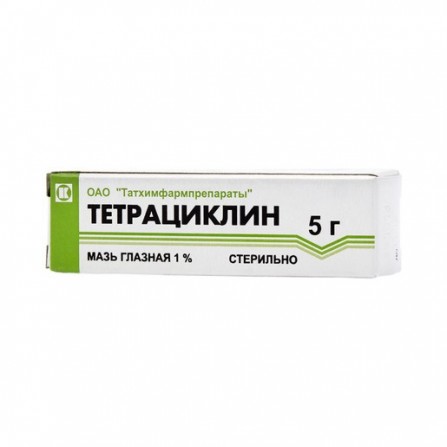Tetracycline ointment ophthalmic 1% 5g
Condition: New product
1000 Items
Rating:
Be the first to write a review!

More info
Active ingredients
Tetracycline
Release form
Ointment
Composition
1 g ointment contains: Active ingredient: tetracycline hydrochloride 10 mg.
Pharmacological effect
Broad-spectrum antibiotic. It has a bacteriostatic effect due to the suppression of protein synthesis of pathogens. Active against aerobic gram-positive bacteria: Staphylococcus spp. (including penicillinase producing strains), Streptococcus spp .; Gram-negative bacteria: Neisseria gonorrhoeae, Bordetella pertussis, Enterobacter spp., Escherichia coli, Klebsiella spp., Salmonella spp., Shigella spp .; anaerobic bacteria: Clostridium spp. Also active against Rickettsia spp., Chlamydia spp., Mycoplasma spp., Spirochaetaceae. Pseudomonas aeruginosa, Proteus spp., Serratia spp. are resistant to tetracycline, and most of the strains of Bacteroides chroma, which are most of Bactero sis.
Pharmacokinetics
After oral administration, 60-80% of the dose is absorbed from the gastrointestinal tract. It is rapidly distributed in most tissues and body fluids. Gets through a placental barrier, it is allocated with breast milk. Excreted in the urine and feces unchanged.
Indications
Infectious and inflammatory diseases caused by microorganisms susceptible to tetracycline, including pneumonia, bronchitis, empyema, angina, cholecystitis, pyelonephritis, intestinal infections, endocarditis, endometritis, prostatitis, syphilis, gonorrhea, brucellosis, rickettsioses, purulent infections of soft tissues, osteomyelitis; trachoma, conjunctivitis, blepharitis; acne. Prevention of postoperative infections.
Contraindications
Hepatic failure, leukopenia, mycoses, children under 8 years of age, pregnancy, lactation (breastfeeding), hypersensitivity to tetracycline.
Use during pregnancy and lactation
Tetracycline is contraindicated during pregnancy and lactation. It penetrates the placental barrier. May cause long-term discoloration of the teeth, enamel hypoplasia, suppression of the growth of the bones of the fetal skeleton. In addition, tetracycline may be the cause of the development of fatty infiltration of the liver.
Dosage and administration
Inside adults - 250-500 mg every 6 hours. Children over 8 years old - 25-50 mg / kg every 6 hours. Apply outwardly several times a day, if necessary, apply a weak bandage. Local - 3-5 times / day. The maximum daily intake for adults when administered orally is 4 g.
Side effects
On the part of the digestive system: nausea, vomiting, anorexia, abdominal pain, diarrhea, constipation, dry mouth, glossitis, discoloration of the tongue, esophagitis, transient increase in liver transaminase, alkaline phosphatase, bilirubin concentration,residual nitrogen. For the central nervous system: dizziness, headache. For the hematopoietic system: neutropenia, thrombocytopenia, hemolytic anemia. Allergic reactions: skin rash, pruritus, eosinophilia, angioedema. Dermatological reactions: photosensitization. Effects caused by chemotherapy; , vulvovaginal candidiasis, intestinal dysbacteriosis. Local reactions: soreness at the injection site. Others: vitamin B deficiency.
Overdose
Data on drug overdose are not available. In case of contact with an excessive amount of the drug, it is recommended to wash the eyes with warm water.
Interaction with other drugs
Preparations containing metal ions (antacids, preparations containing iron, magnesium, calcium) form inactive chelates with tetracycline, and therefore it is necessary to avoid their simultaneous use. It is necessary to avoid combination with penicillins, cephalosporins, which have a bactericidal effect and are antagonists of bacteriostatic antibiotics (including tetracycline). With the simultaneous use of tetracycline with retinol, the development of intracranial hypertension is possible. When used simultaneously with Kolestiramine or to Olestipol marked violation of tetracycline absorption.
special instructions
With long-term use, it is necessary to periodically monitor the functions of the kidneys, liver, hematopoietic organs. The use of tetracycline in children during the development of teeth can lead to an irreversible change in their color. During treatment, vitamin B, K, brewer's yeast should be used to prevent hypovitaminosis. simultaneously with milk and other dairy products, since at the same time absorption of an antibiotic is broken.




